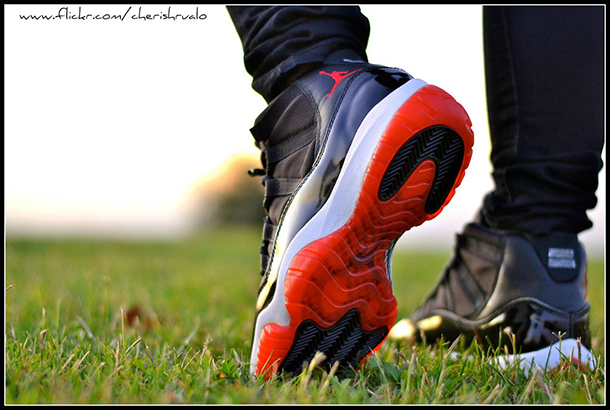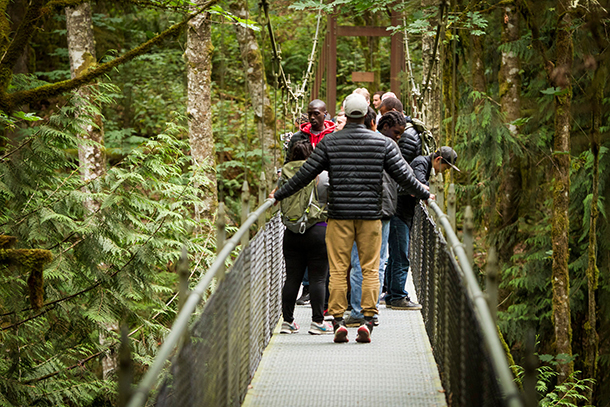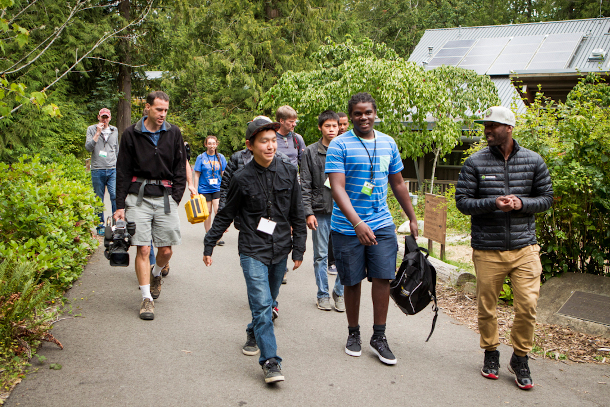Why I Wear Jordans in the Great Outdoors
Air Date: Week of April 9, 2021

CJ Goulding has only ever owned one pair of Air Jordans – a status symbol to some African-Americans -- but he’s not too concerned with keeping them pristine. (Photo: Cherish, Flickr CC BY-ND 2.0)
Some stereotypes in the US among people of European descent about who can be “outdoorsy” can leave people of color out, so environmental educator CJ Goulding actively and creatively works to encourage young people of color to feel that they belong in the outdoors, too. CJ Goulding speaks with Host Steve Curwood about how his Air Jordan “Bred” 11 sneakers help him link young people of color to the great outdoors.
Transcript
CURWOOD: It’s Living on Earth I’m Steve Curwood.
Plenty of backpackers wear special hiking boots when they are out on the trail, but not C.J. Goulding. CJ is a Program Manager for the Children and Nature Network and when he leads young folks out for a hike CJ himself wears Nike sneakers called Air Jordans. Here’s an excerpt from his blog on why.
GOULDING: I am an African American natural leader. That phrase is not an oxymoron but it's also not something that you normally see in the environmental world. In the few years that I've been involved in environmental education and connecting people with outdoor spaces, there have been numerous occasions where I'm the only person of color in the program, or the only African American leader. Growing up, there was no one from my neighborhood traveling, hiking, canoeing, or spending time outdoors unless it was a part of a regimented program.
But do not misunderstand the meaning behind that statement. Do not miss my point. I write neither to complain that the outdoor world is an elitist one, nor to lament the disconnect between the world I grew up in and the natural world where I now lay roots. I write to celebrate the amazing opportunity available for me and others like myself to be a bridge between the two worlds.
On my feet as I write our Jordan Bred 11s the only pair of Michael Jordan sneakers I've ever owned in my life. His sneakers are a status symbol in the neighborhood I grew up in, a memento of importance and significance. Unfortunately for some people, they hold higher value than food, books rent, and in some extreme cases, even the life and well being of another individual.
So it makes sense that while facilitating an outdoor youth summit at Harpers Ferry National Park in Virginia, an African American teenage boy stopped me to ask why I was wearing these Bred 11s outdoors. I laughed. I asked him if he had seen anyone who would wear Jordans exploring the outdoors like we were. He said no. Right there, the disconnect between the two circles was evident and as we looked around, we could see that even there at that event, we were in the minority.
I've heard the rallying cry echo, through the trees affirming that the outdoors are for people of all creeds, countries and colors.
My Jordans are now falling apart, worn from adventures in places like the Grand Tetons and the Grand Canyon. Hiking through the topography of Los Angeles and Arctic Village. This goes directly against how people quote unquote should wear them and what people quote unquote should wear outdoors. But I wear them wherever I go to remind me of the fact that though there are two worlds, I am a bridge. And I'm constantly reassured of its validity whenever I see another young leader follow the footprints of my Bred 11s into the woods.

CJ Goulding leads participants from Los Angeles and Alaska in the Fresh Tracks: Leadership Program. Fresh Tracks is a cultural exchange program that builds participant skill/knowledge in cultural competence, civic engagement, and hometown stewardship. (Photo: Tony Teske)
CURWOOD: So CJ, what was the outdoors experience that hooked you?
GOULDING: Growing up as a kid I was a wanderer and so I'd just explore the neighborhood, the trees, any forested areas, my grandmother's backyard, spending a lot of time working in her garden, and planting things and flowers and vegetables and things like that. So that's a key component of my environmental ethos.
CURWOOD: CJ, what do you think it is that keeps Black people away from nature here in the United States?
GOULDING: I think white supremacy has existed to amplify the disconnect that we have had with nature. A lot of times, history of Black people and African Americans is told starting at slavery, and that's not true. Before that, way before that we had a connection to the land, we had a connection to each other and communities. And so oftentimes, that story gets lost. And it's on purpose because a grounding and a connection in nature, amplifies and completes us and strengthens our culture. So that disconnect shows up through the way that communities of color and black people live inside inner cities with not easy access to nature, that shows up in the way that our education doesn't include that kind of knowledge. That shows up in the way that white folks have taken over some of these industries connected to the outdoors and made them an experience that requires a lot of time and a lot of money. So that connection is always with us. But I think white supremacy showed up in a way that wants to separate us from these life giving qualities.

CJ Goulding has been involved in REI’s #OptOutside campaign, which is aimed at connecting people to nature and reducing waste across the outdoor industry. (Photo: Tony Teske, REI)
CURWOOD: Tell me how do you think the the Jordans Bred 11 helped to connect with folks.
GOULDING: I call it my stepping stone theory. And for me the idea of connecting people to nature or connecting people to anything unfamiliar sometimes it's like a river that's or a creek that's running by and you can't jump it immediately. You're not comfortable enough to make that large leap. And so the Jordans helped me to be that stepping stone in the middle where I'm able to build a connection with someone and help them feel comfortable stepping into the middle because they understand that I'm there. They connect to me because I'm showing up as myself because they understand that I know who they are and where they come from. And then they feel more comfortable stepping into that unknown whether it's nature or anything else in terms of development and exposure that they're looking for.
CURWOOD: So, to what extent did you get pushback or question or even ridicule from white people who saw your show up in what they see is anachronistically his tennis shoes?
GOULDING: I think sometimes it shows up as 'hey, you're not wearing the right shoes' because they think they know the correct shoes to wear outside or outdoors and understanding that the outdoors can get to gear centric and you really don't need right shoes. You don't need $120, $200 boots to go outside. All you need are the sneakers that are on your feet.

CJ Goulding is lead organizer at the Natural Leaders Network based in Seattle, Washington. (Photo: Tony Teske)
CURWOOD: Those Jordans aren't cheap though.
GOULDING: Well mine where I got those for $4.95 at a thrift store in Alabama, so I would definitely consider that inexpensive.
CURWOOD: So after they said those aren't the right shoes, what did you say to them?
GOULDING: I don't care. [LAUGH] I mean, I realized that I had something to teach them as much as they had to teach me. Understanding that there are some cases where I need special gear and equipment and then understanding that there are some cases where it's just marketing. And I knew that my primary purpose was one to stay safe and I was doing that but ultimately to connect with the young adults I was working with.
CURWOOD: CJ Golding is a program manager for the children and Nature Network. CJ, thanks so much for taking the time with us today.
GOULDING: Thanks for having me.
Links
CJ Goulding's essay is featured in the book, “Coming of Age at the End of Nature”
Living on Earth wants to hear from you!
Living on Earth
62 Calef Highway, Suite 212
Lee, NH 03861
Telephone: 617-287-4121
E-mail: comments@loe.org
Newsletter [Click here]
Donate to Living on Earth!
Living on Earth is an independent media program and relies entirely on contributions from listeners and institutions supporting public service. Please donate now to preserve an independent environmental voice.
NewsletterLiving on Earth offers a weekly delivery of the show's rundown to your mailbox. Sign up for our newsletter today!
 Sailors For The Sea: Be the change you want to sea.
Sailors For The Sea: Be the change you want to sea.
 The Grantham Foundation for the Protection of the Environment: Committed to protecting and improving the health of the global environment.
The Grantham Foundation for the Protection of the Environment: Committed to protecting and improving the health of the global environment.
 Contribute to Living on Earth and receive, as our gift to you, an archival print of one of Mark Seth Lender's extraordinary wildlife photographs. Follow the link to see Mark's current collection of photographs.
Contribute to Living on Earth and receive, as our gift to you, an archival print of one of Mark Seth Lender's extraordinary wildlife photographs. Follow the link to see Mark's current collection of photographs.
 Buy a signed copy of Mark Seth Lender's book Smeagull the Seagull & support Living on Earth
Buy a signed copy of Mark Seth Lender's book Smeagull the Seagull & support Living on Earth

